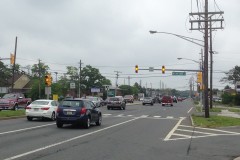Has your drive on Brick Boulevard seemed a bit snappier over the past month? If so, you weren’t imaging things.
County officials say traffic along the entire 8.8 mile stretch of roadway that comprises Brick Boulevard and Hooper Avenue sped up by an average of almost 20 percent over the past month following the start of an improved traffic light schedule.
Technically called “signal optimization,” traffic engineers used technology provided through a federal grant to track traffic light signals and make mathematical calculations as to how traffic would be move along. The changes were implemented May 4.
|
|
The initial data shows that traffic sped up most during the heaviest traffic period of the day, considered to be midday from late morning to early afternoon. During that time period, traffic moved 24 percent faster through the corridor, and a motorist driving from Route 70 in Brick to Route 37 in Toms River would save 5.7 minutes on their drive. During the morning rush hour, motorists saved 4.1 minutes. Overall, traffic moved 17 to 18 percent faster on average.
The improvements took a lot of math, but were based on a simple concept, explained Mark Jehnke, a traffic engineer with the county.
“You coordinate the signals so, as you’re traveling down the road at the posted speed limit, you’re going to hit less red lights,” Jehnke said.
Since the traffic lights are timed to be in sync with the speed limit, speeders may, ironically, fall behind the pack since they will hit more red lights.
“You’re still going to hit a few, and if you don’t travel the speed limit it will be out of sync,” Jehnke said.
The federal government contributed 80 percent of the $217,047 cost of the project, which involved engineers using cameras, Bluetooth and GPS devices in vehicles to map out how traffic flows through what Jehnke described as the county’s most heavily-traveled corridor. In addition to the traffic light intervals, the project resulted in updated pedestrian clearance times and updated yellow and red light clearance times for safety purposes.
Though completed, engineers are still tweaking the lights to make them as optimally-set as possible.
“You can go back and look at the videotape after to validate your model, and if there are any concerns after, you have a historical record,” said Jehnke, adding that some such tweaks would likely be made next week to improve things even more.
Of course, there will always be trouble spots, with the worst offender being located near the Brick-Toms River border, where Hooper Avenue intersects with Kettle Creek Road.
“We can’t add any more lanes there, so we’re looking to see what we can do with the intersection,” said County Engineer Frank Scarantino.
The data derived from the traffic study may eventually be used to usher in a system of adaptive traffic lights that sync automatically as traffic increases and decreases, officials said. Such equipment is proprietary and would cost the county about $2 million, but it would likely speed up traffic even more.
“It would probably squeeze another 25 percent out of the system and should be considered sometime in the future,” Scarantino said.

Advertisement

Police, Fire & Courts
Teacher From Brick, 36, Charged With Carrying on Affair With Student
Brick Life
Adult Autism Transition

Police, Fire & Courts
Teacher From Brick Charged in Another Sex Affair With Student









